Towards a Smart City: Development and Application of an Improved Integrated Environmental Monitoring System
Abstract
:1. Introduction
2. Towards a Smart City
3. Development of Smart Technology: An Improved Integrated Environmental Monitoring System
3.1. System Architecture
3.2. Calibration Tests
4. Application of the Improved Integrated Environmental Monitoring System
4.1. Study Site
4.2. Typhoon Tests
4.3. Urban Road/Park Tests
5. Results
5.1. Calibration of IIEMS
5.2. Application I: Typhoon Tests
5.3. Application II: Urban Road/Park Tests
6. Implications of Sustainable Planning with IIEMS
7. Conclusions
Acknowledgments
Author Contributions
Conflicts of Interest
References
- Heaviside, C.; Tsangari, H.; Paschalidou, A.; Vardoulakis, S.; Kassomenos, P.; Georgiou, K.E.; Yamasaki, E.N. Heat-related mortality in Cyprus for current and future climate scenarios. Sci. Total Environ. 2016, 569, 627–633. [Google Scholar] [CrossRef] [PubMed]
- Willers, S.M.; Jonker, M.F.; Klok, L.; Keuken, M.P.; Odink, J.; van den Elshout, S.; Sabel, C.E.; Mackenbach, J.P.; Burdorf, A. High resolution exposure modelling of heat and air pollution and the impact on mortality. Environ. Int. 2016, 89, 102–109. [Google Scholar] [CrossRef] [PubMed]
- Boman, B.C.; Forsberg, A.B.; Järvholm, B.G. Adverse health effects from ambient air pollution in relation to residential wood combustion in modern society. Scand. J. Work Environ. Health 2003, 29, 251–260. [Google Scholar] [CrossRef] [PubMed]
- Ho, H.C.; Wong, M.S.; Yang, L.; Shi, W.; Yang, J.; Bilal, M.; Chan, T.C. Spatiotemporal influence of temperature, air quality, and urban environment on cause-specific mortality during hazy days. Environ. Int. 2018, 112, 10–22. [Google Scholar] [CrossRef] [PubMed]
- Ho, H.C.; Wong, M.S.; Yang, L.; Chan, T.C.; Bilal, M. Influences of socioeconomic vulnerability and intra-urban air pollution exposure on short-term mortality during extreme dust events. Environ. Pollut. 2018, 235, 155–162. [Google Scholar] [CrossRef] [PubMed]
- Lu, F.; Xu, D.; Cheng, Y.; Dong, S.; Guo, C.; Jiang, X.; Zheng, X. Systematic review and meta-analysis of the adverse health effects of ambient PM2.5 and PM10 pollution in the Chinese population. Environ. Res. 2015, 136, 196–204. [Google Scholar] [CrossRef] [PubMed]
- Tam, W.W.; Wong, T.W.; Ng, L.; Wong, S.Y.; Kung, K.K.; Wong, A.H. Association between air pollution and general outpatient clinic consultations for upper respiratory tract infections in Hong Kong. PLoS ONE 2014, 9, e86913. [Google Scholar] [CrossRef] [PubMed] [Green Version]
- Valavanidis, A.; Fiotakis, K.; Vlachogianni, T. Airborne particulate matter and human health: Toxicological assessment and importance of size and composition of particles for oxidative damage and carcinogenic mechanisms. J. Environ. Sci. Health Part C 2008, 26, 339–362. [Google Scholar] [CrossRef] [PubMed]
- Weichenthal, S.A.; Pollitt, K.G.; Villeneuve, P.J. PM2.5, oxidant defence and cardiorespiratory health: A review. Environ. Health 2013, 12, 1. [Google Scholar] [CrossRef] [PubMed]
- Chien, L.C.; Guo, Y.; Zhang, K. Spatiotemporal analysis of heat and heat wave effects on elderly mortality in Texas, 2006–2011. Sci. Total Environ. 2016, 562, 845–851. [Google Scholar] [CrossRef] [PubMed]
- Hattis, D.; Ogneva-Himmelberger, Y.; Ratick, S. The spatial variability of heat-related mortality in Massachusetts. Appl. Geogr. 2012, 33, 45–52. [Google Scholar] [CrossRef]
- Hondula, D.M.; Davis, R.E.; Leisten, M.J.; Saha, M.V.; Veazey, L.M.; Wegner, C.R. Fine-scale spatial variability of heat-related mortality in Philadelphia County, USA, from 1983–2008: A case-series analysis. Environ. Health 2012, 11, 1. [Google Scholar] [CrossRef] [PubMed]
- Jerrett, M.; Burnett, R.; Willis, A.; Krewski, D.; Goldberg, M.; DeLuca, P.; Finkelstein, N. Spatial analysis of the air pollution—Mortality relationship in the context of ecologic confounders. J. Toxicol. Environ. Health Part A 2003, 66, 1735–1778. [Google Scholar] [CrossRef] [PubMed]
- Jerrett, M.; Burnett, R.T.; Ma, R.; Pope, C.A., III; Krewski, D.; Newbold, K.B.; Thurston, G.; Shi, Y.; Finkelstein, N.; Calle, E.E.; et al. Spatial analysis of air pollution and mortality in Los Angeles. Epidemiology 2005, 16, 727–736. [Google Scholar] [CrossRef] [PubMed]
- Jerrett, M.; Burnett, R.T.; Beckerman, B.S.; Turner, M.C.; Krewski, D.; Thurston, G.; Martin, R.V.; van Donkelaar, A.; Hughes, E.; Shi, Y.; et al. Spatial analysis of air pollution and mortality in California. Am. J. Respir. Crit. Care Med. 2013, 188, 593–599. [Google Scholar] [CrossRef] [PubMed]
- Park, Y.M.; Kwan, M.P. Individual exposure estimates may be erroneous when spatiotemporal variability of air pollution and human mobility are ignored. Health Place 2017, 43, 85–94. [Google Scholar] [CrossRef] [PubMed]
- Tsin, P.K.; Knudby, A.; Krayenhoff, E.S.; Ho, H.C.; Brauer, M.; Henderson, S.B. Microscale mobile monitoring of urban air temperature. Urban Clim. 2016, 18, 58–72. [Google Scholar] [CrossRef]
- Bilal, M.; Nichol, J.E.; Spak, S.N. A new approach for estimation of fine particulate concentrations using satellite aerosol optical depth and binning of meteorological variables. Aerosol. Air Qual. Res. 2017, 17, 356–367. [Google Scholar] [CrossRef]
- Dousset, B.; Gourmelon, F.; Laaidi, K.; Zeghnoun, A.; Giraudet, E.; Bretin, P.; Mauri, E.; Vandentorren, S. Satellite monitoring of summer heat waves in the Paris metropolitan area. Int. J. Climatol. 2011, 31, 313–323. [Google Scholar] [CrossRef]
- Ho, H.C.; Knudby, A.; Sirovyak, P.; Xu, Y.; Hodul, M.; Henderson, S.B. Mapping maximum urban air temperature on hot summer days. Remote Sens. Environ. 2014, 154, 38–45. [Google Scholar] [CrossRef]
- Lai, P.C.; Choi, C.C.; Wong, P.P.; Thach, T.Q.; Wong, M.S.; Cheng, W.; Krämer, A.; Wong, C.M. Spatial analytical methods for deriving a historical map of physiological equivalent temperature of Hong Kong. Build. Environ. 2016, 99, 22–28. [Google Scholar] [CrossRef]
- Kestens, Y.; Brand, A.; Fournier, M.; Goudreau, S.; Kosatsky, T.; Maloley, M.; Smargiassi, A. Modelling the variation of land surface temperature as determinant of risk of heat-related health events. Int. J. Health Geogra. 2011, 10, 1. [Google Scholar] [CrossRef] [PubMed]
- Zou, B.; Pu, Q.; Bilal, M.; Weng, Q.; Zhai, L.; Nichol, J.E. High-Resolution Satellite Mapping of Fine Particulates Based on Geographically Weighted Regression. IEEE Geosci. Remote Sens. Lett. 2016, 13, 495–499. [Google Scholar] [CrossRef]
- Ho, H.C.; Knudby, A.; Walker, B.B.; Henderson, S.B. Delineation of spatial variability in the temperature–mortality relationship on extremely hot days in greater Vancouver, Canada. Environ. Health Perspect. 2017, 125, 66. [Google Scholar] [CrossRef] [PubMed]
- Laaidi, K.; Zeghnoun, A.; Dousset, B.; Bretin, P.; Vandentorren, S.; Giraudet, E.; Beaudeau, P. The impact of heat islands on mortality in Paris during the August 2003 heat wave. Environ. Health Perspect. 2012, 120, 254. [Google Scholar] [CrossRef] [PubMed]
- Smargiassi, A.; Goldberg, M.S.; Plante, C.; Fournier, M.; Baudouin, Y.; Kosatsky, T. Variation of daily warm season mortality as a function of micro-urban heat islands. J. Epidemiol. Commun. Health 2009, 63, 659–664. [Google Scholar] [CrossRef] [PubMed]
- Thach, T.Q.; Zheng, Q.; Lai, P.C.; Wong, P.P.Y.; Chau, P.Y.K.; Jahn, H.J.; Plass, D.; Katzschner, L.; Kraemer, A.; Wong, C.M. Assessing spatial associations between thermal stress and mortality in Hong Kong: A small-area ecological study. Sci. Total Environ. 2015, 502, 666–672. [Google Scholar] [CrossRef] [PubMed]
- Wong, M.S.; Ho, H.C.; Yang, L.; Shi, W.; Yang, J.; Chan, T. Spatial variability of excess mortality during prolonged dust events in a high-density city: A time-stratified spatial regression approach. International J. Health Geogra. 2017, 16, 26. [Google Scholar] [CrossRef] [PubMed]
- Goodchild, M.F. Citizens as sensors: The world of volunteered geography. GeoJournal 2007, 69, 211–221. [Google Scholar] [CrossRef]
- Al-Hader, M.; Rodzi, A. The smart city infrastructure development & monitoring. Theoret. Empir. Res. Urban Manag. 2009, 4, 87–94. [Google Scholar]
- Gaur, A.; Scotney, B.; Parr, G.; McClean, S. Smart city architecture and its applications based on IoT. Procedia Comput. Sci. 2015, 52, 1089–1094. [Google Scholar] [CrossRef]
- Jin, J.; Gubbi, J.; Marusic, S.; Palaniswami, M. An information framework for creating a smart city through internet of things. IEEE Internet Things J. 2014, 1, 112–121. [Google Scholar] [CrossRef]
- Ochian, A.; Suciu, G.; Fratu, O.; Suciu, V. Big data search for environmental telemetry. In Proceedings of the 2014 IEEE International Black Sea Conference on Communications and Networking Communications and Networking (BlackSeaCom), Odessa, Ukraine, 27–30 May 2014; pp. 182–184. [Google Scholar]
- Honicky, R.; Brewer, E.A.; Paulos, E.; White, R. N-smarts: Networked suite of mobile atmospheric real-time sensors. In Proceedings of the Second ACM SIGCOMM Workshop on Networked Systems for Developing Regions, Kyoto, Japan, 27 August 2018; pp. 25–30. [Google Scholar]
- Kanjo, E.; Benford, S.; Paxton, M.; Chamberlain, A.; Fraser, D.S.; Woodgate, D.; Crellin, D.; Woolard, A. MobGeoSen: Facilitating personal geosensor data collection and visualization using mobile phones. Pers. Ubiquitous Comput. 2008, 12, 599–607. [Google Scholar] [CrossRef]
- Dutta, P.; Aoki, P.M.; Kumar, N.; Mainwaring, A.; Myers, C.; Willett, W.; Woodruff, A. Common sense: Participatory urban sensing using a network of handheld air quality monitors. In Proceedings of the 7th ACM Conference on Embedded Networked Sensor Systems, Berkeley, CA, USA, 4–6 November 2009; pp. 349–350. [Google Scholar]
- Mead, M.I.; Popoola, O.A.M.; Stewart, G.B.; Landshoff, P.; Calleja, M.; Hayes, M.; Baldovi, J.K.; McLeod, M.W.; Hodgson, T.F.; DIcks, J.; et al. The use of electrochemical sensors for monitoring urban air quality in low-cost, high-density networks. Atmos. Environ. 2013, 70, 186–203. [Google Scholar] [CrossRef]
- Sun, L.; Wong, K.C.; Wei, P.; Ye, S.; Huang, H.; Yang, F.; Westerdahl, D.; Louie, P.K.K.; Luk, C.W.Y.; Ning, Z. Development and application of a next generation air sensor network for the Hong Kong marathon 2015 air quality monitoring. Sensors 2016, 16, 211. [Google Scholar] [CrossRef] [PubMed]
- Wong, M.S.; Yip, T.P.; Mok, E. Development of a personal integrated environmental monitoring system. Sensors 2014, 14, 22065–22081. [Google Scholar] [CrossRef] [PubMed]
- Shultz, J.M.; Russell, J.; Espinel, Z. Epidemiology of tropical cyclones: The dynamics of disaster, disease, and development. Epidemiol. Rev. 2005, 27, 21–35. [Google Scholar] [CrossRef] [PubMed]
- Feizizadeh, B.; Blaschke, T. Examining urban heat island relations to land use and air pollution: Multiple endmember spectral mixture analysis for thermal remote sensing. IEEE J. Sel. Topics Appl. Earth Observ. Remote Sens. 2013, 6, 1749–1756. [Google Scholar] [CrossRef]
- Vailshery, L.S.; Jaganmohan, M.; Nagendra, H. Effect of street trees on microclimate and air pollution in a tropical city. Urban For. Urban Green. 2013, 12, 408–415. [Google Scholar] [CrossRef]
- EPD. Past 24 Hours Pollutant Concentration. Available online: http://www.aqhi.gov.hk/en/aqhi/past-24-hours-pollutant-concentration9c57.html?stationid=81 (accessed on 9 October 2016).
- Hyndman, R.J.; Koehler, A.B. Another look at measures of forecast accuracy. Int. J. Forecast. 2006, 22, 679–688. [Google Scholar] [CrossRef]
- Tofallis, C. A better measure of relative prediction accuracy for model selection and model estimation. J. Oper. Res. Soc. 2015, 66, 1352–1362. [Google Scholar] [CrossRef]
- Peng, F.; Wong, M.S.; Ho, H.C.; Nichol, J.; Chan, P.W. Reconstruction of historical datasets for analyzing spatiotemporal influence of built environment on urban microclimates across a compact city. Build. Environ. 2017, 123, 649–660. [Google Scholar] [CrossRef]
- Shu, Z.R.; Li, Q.S.; He, Y.C.; Chan, P.W. Vertical wind profiles for typhoon, monsoon and thunderstorm winds. J. Wind Eng. Ind. Aerodyn. 2017, 168, 190–199. [Google Scholar] [CrossRef]
- Lo, A.Y.; Byrne, J.A.; Jim, C.Y. How climate change perception is reshaping attitudes towards the functional benefits of urban trees and green space: Lessons from Hong Kong. Urban For. Urban Green. 2017, 23, 74–83. [Google Scholar] [CrossRef]
- Tropical Storm Risk Consortium. July Forecast Update for Northwest Pacific Typhoon Activity in 2016. Available online: https://www.tropicalstormrisk.com/docs/TSRNWPForecastJul2016.pdf (accessed on 9 October 2016).
- Wang, J.; Ogawa, S. Effects of meteorological conditions on PM2. 5 concentrations in Nagasaki, Japan. Int. J. Environ. Res. Public Health 2015, 12, 9089–9101. [Google Scholar] [CrossRef] [PubMed]
- Liu, Z.; Howard-Reed, C.; Cox, S.S.; Ye, W.; Little, J.C. Diffusion-controlled reference material for VOC emissions testing: Effect of temperature and humidity. Indoor Air 2014, 24, 283–291. [Google Scholar] [CrossRef] [PubMed]
- Zhang, H.; Wang, Y.; Hu, J.; Ying, Q.; Hu, X.M. Relationships between meteorological parameters and criteria air pollutants in three megacities in China. Environ. Res. 2015, 140, 242–254. [Google Scholar] [CrossRef] [PubMed]
- Aflaki, A.; Mirnezhad, M.; Ghaffarianhoseini, A.; Ghaffarianhoseini, A.; Omrany, H.; Wang, Z.H.; Akbari, H. Urban heat island mitigation strategies: A state-of-the-art review on Kuala Lumpur, Singapore and Hong Kong. Cities 2017, 62, 131–145. [Google Scholar] [CrossRef]
- Kong, F.; Yin, H.; James, P.; Hutyra, L.R.; He, H.S. Effects of spatial pattern of greenspace on urban cooling in a large metropolitan area of eastern China. Landsc. Urban Plan. 2014, 128, 35–47. [Google Scholar] [CrossRef]
- Margaritis, E.; Kang, J. Relationship between green space-related morphology and noise pollution. Ecol. Indicators 2017, 72, 921–933. [Google Scholar] [CrossRef]
- Van Renterghem, T.; Attenborough, K.; Maennel, M.; Defrance, J.; Horoshenkov, K.; Kang, J.; Bashir, I.; Taherzadeh, S.; Altreuther, B.; Khan, A.; et al. Measured light vehicle noise reduction by hedges. Appl. Acoust. 2014, 78, 19–27. [Google Scholar] [CrossRef]
- Wong, P.P.Y.; Lai, P.C.; Low, C.T.; Chen, S.; Hart, M. The impact of environmental and human factors on urban heat and microclimate variability. Build. Environ. 2016, 95, 199–208. [Google Scholar] [CrossRef]
- Buyantuyev, A.; Wu, J. Urban heat islands and landscape heterogeneity: Linking spatiotemporal variations in surface temperatures to land-cover and socioeconomic patterns. Landsc. Ecol. 2010, 25, 17–33. [Google Scholar] [CrossRef]
- Stabler, L.B.; Martin, C.A.; Brazel, A.J. Microclimates in a desert city were related to land use and vegetation index. Urban For. Urban Green. 2005, 3, 137–147. [Google Scholar] [CrossRef]
- Weng, Q.; Yang, S. Urban air pollution patterns, land use, and thermal landscape: An examination of the linkage using GIS. Environ. Monit. Assess. 2006, 117, 463–489. [Google Scholar] [CrossRef] [PubMed]
- Shi, Y.; Lau, K.K.L.; Ng, E. Developing street-level PM2.5 and PM10 land use regression models in high-density Hong Kong with urban morphological factors. Environ. Sci. Technol. 2016, 50, 8178–8187. [Google Scholar] [CrossRef] [PubMed]
- Haklay, M. Citizen science and volunteered geographic information: Overview and typology of participation. In Crowdsourcing Geographic Knowledge; Springer: Berlin, Germany, 2012; pp. 105–122. [Google Scholar]
- Weather Underground. Weather Forecast & Reports—Long Range & Local. Available online: https://www.wunderground.com/ (accessed on 9 October 2016).
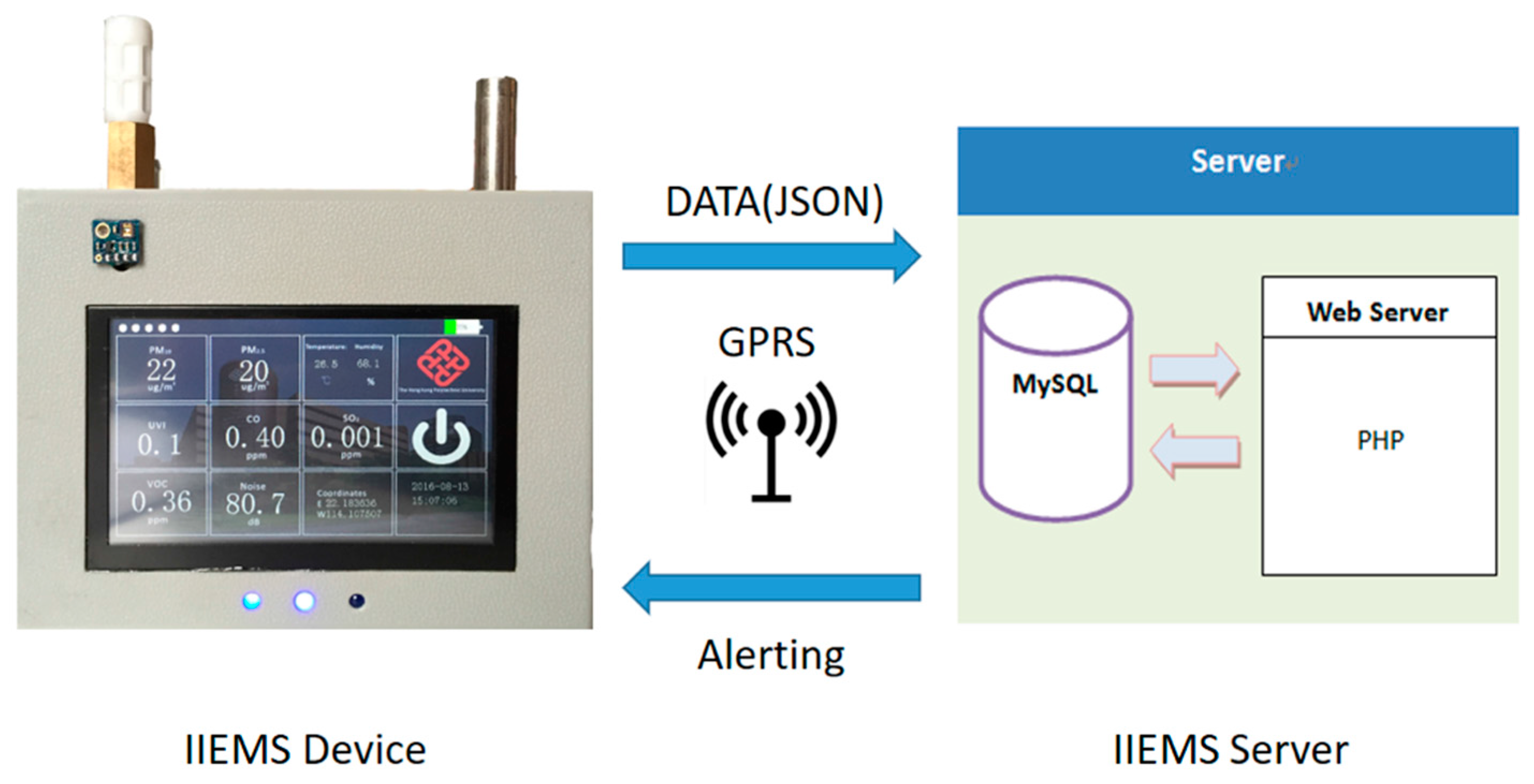
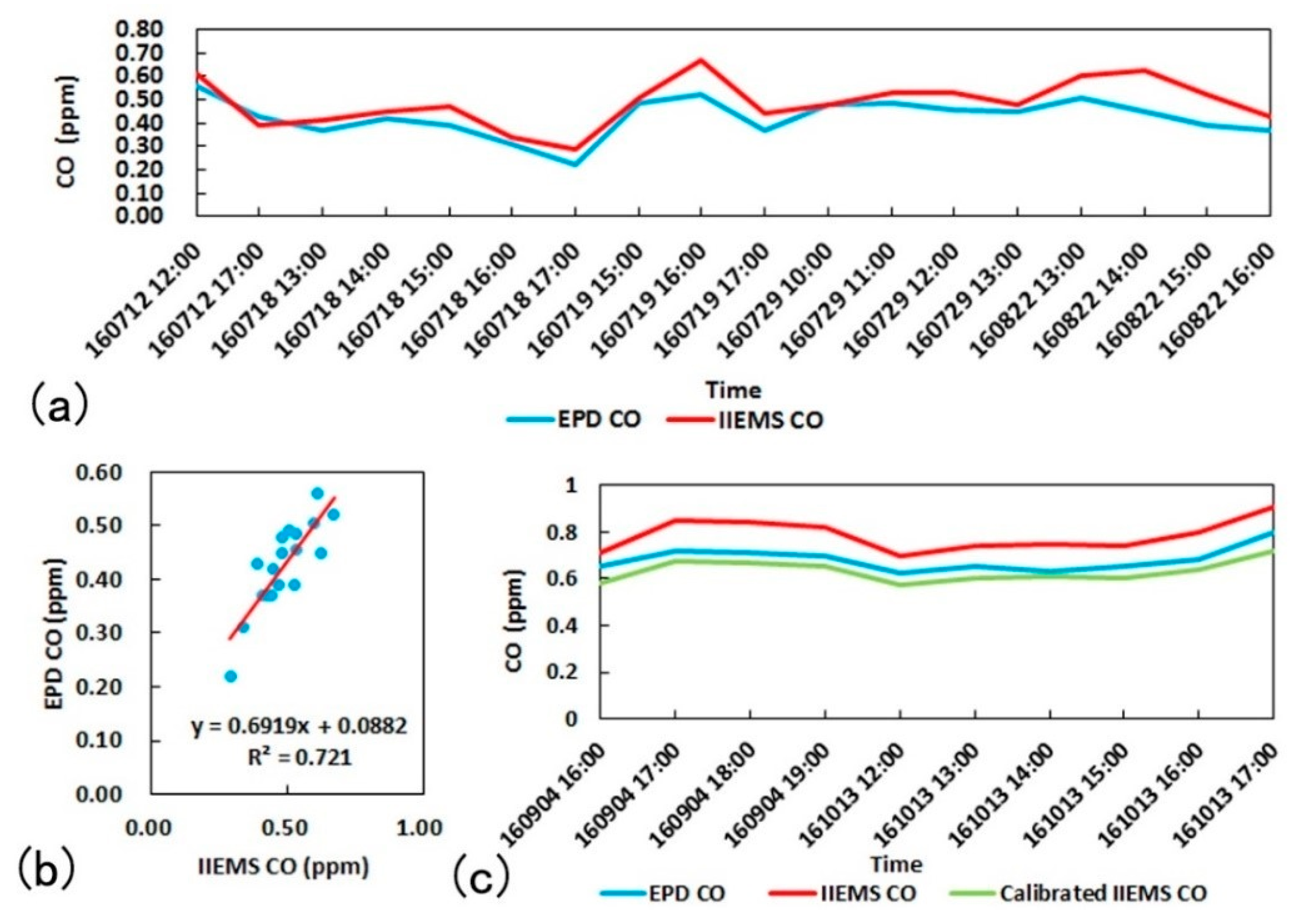
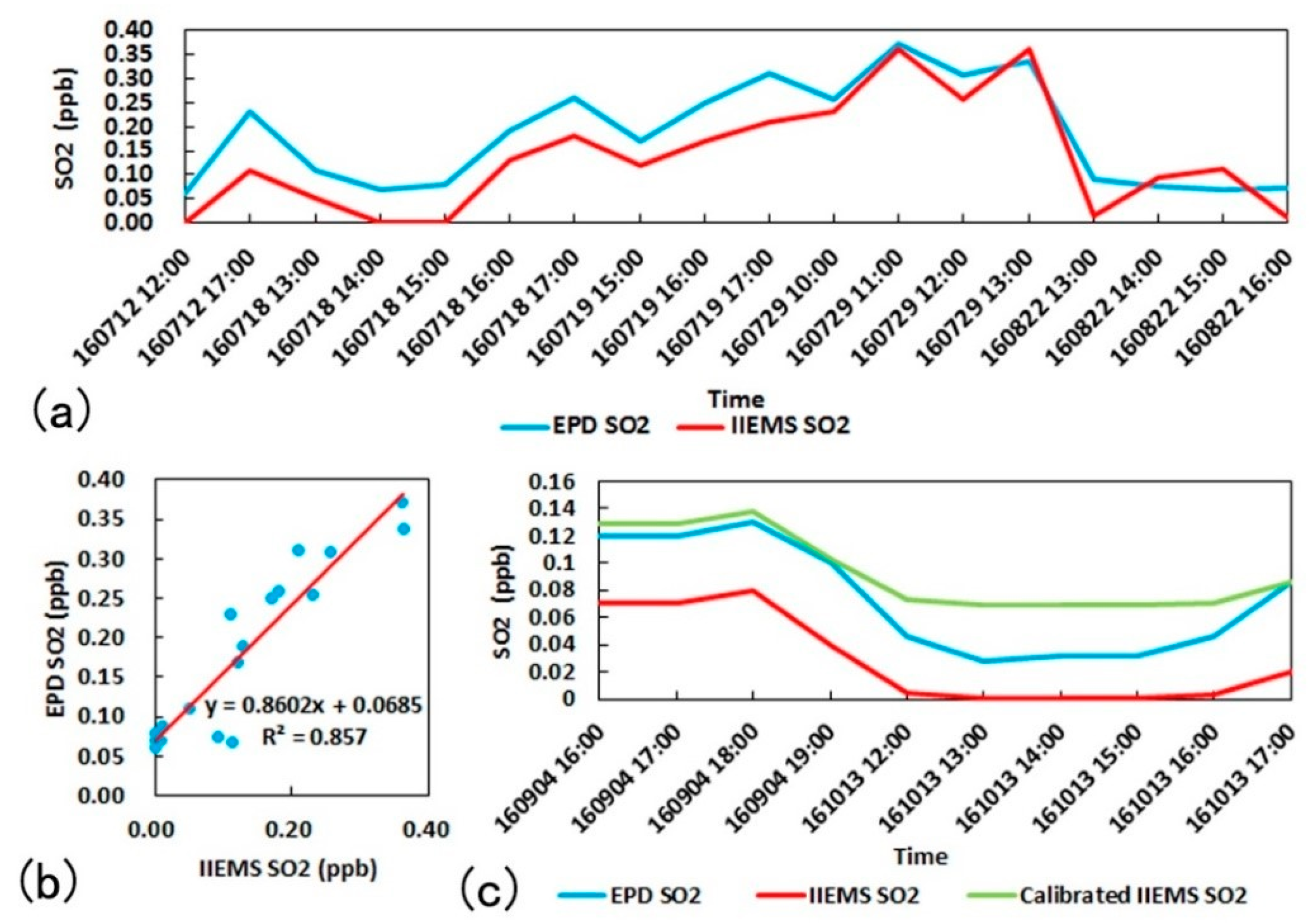
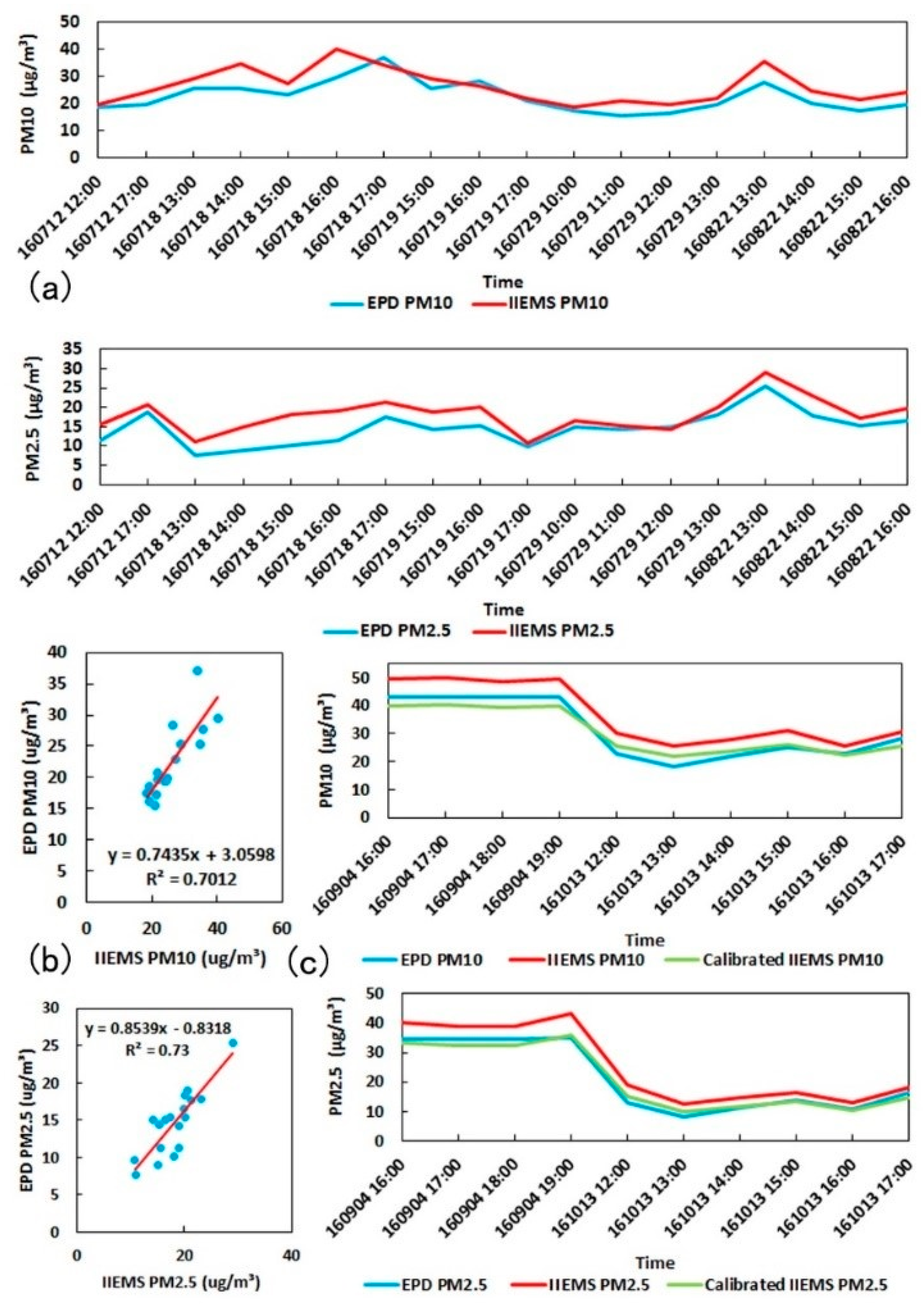
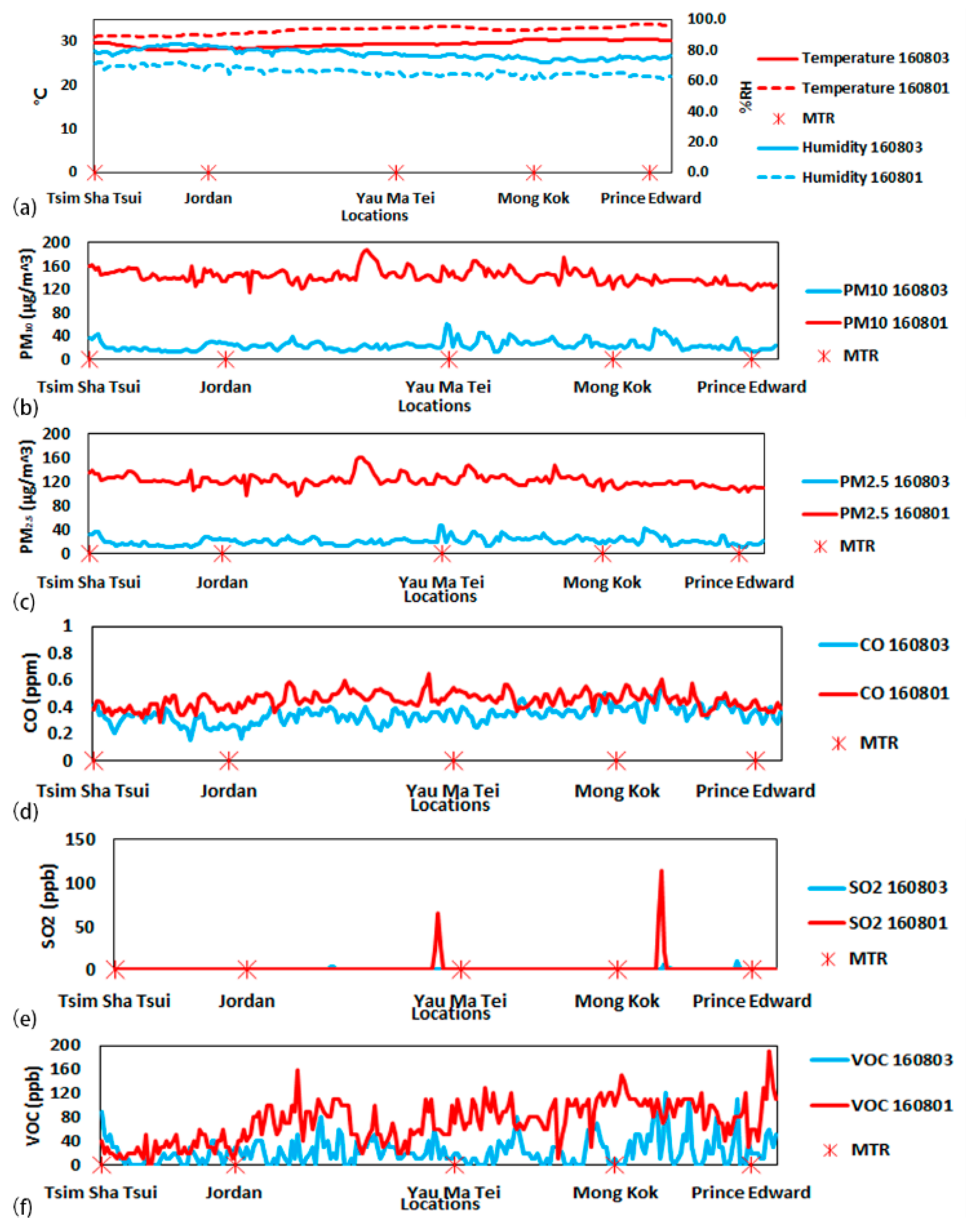
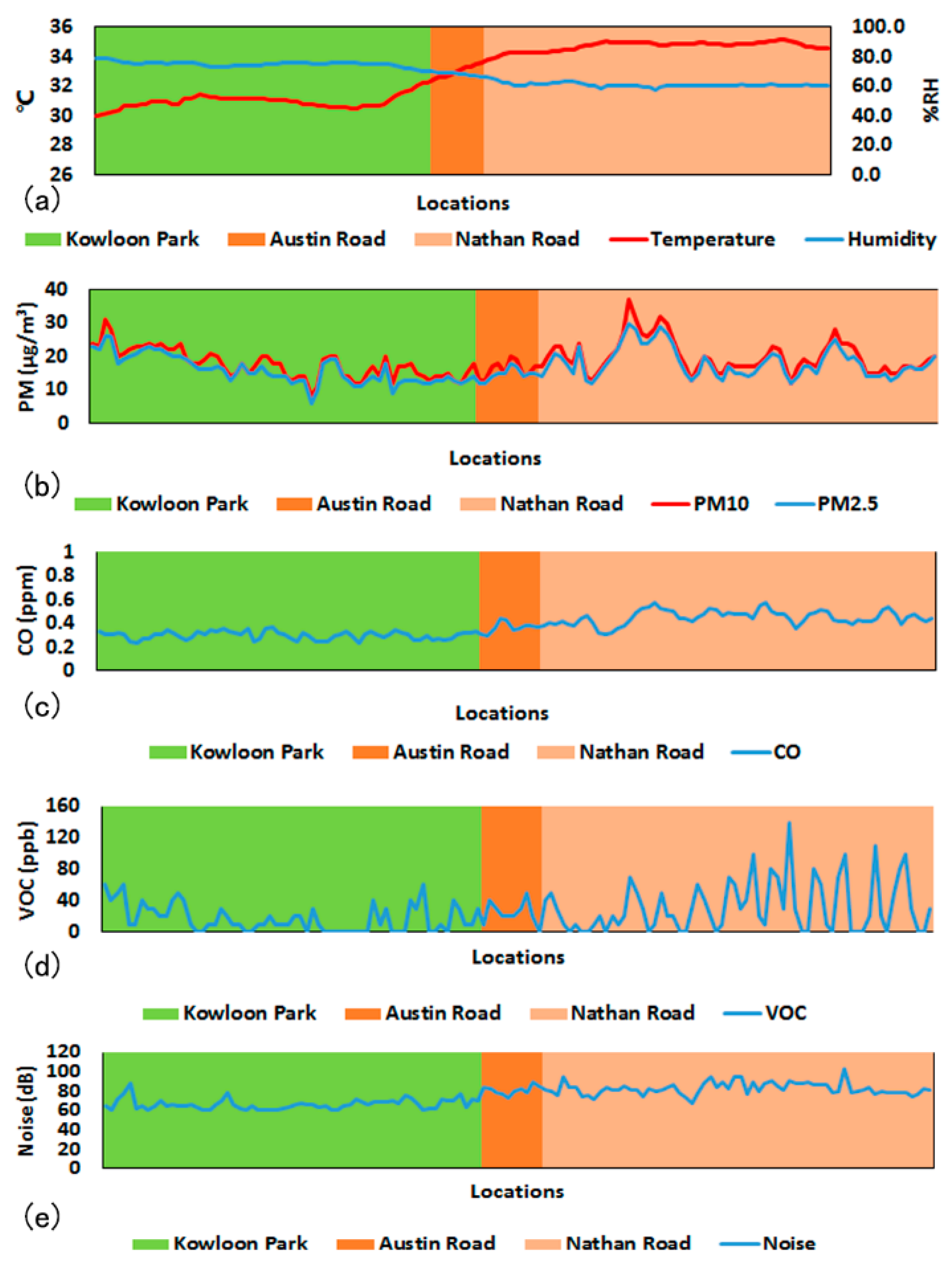
| Sensors | Relative Error | Range | Resolution |
|---|---|---|---|
| Temperature | ±0.3 °C | −25 °C–125 °C | 0.01 °C |
| Relative Humidity | ±1.8% | 0–100% | 0.03% |
| CO | ≤±2% FS | 0–500 ppm | ≤0.1 ppm |
| VOC (formaldehyde) | ≤±3% FS | 0–10 ppm | ≤0.01 ppm |
| SO2 | ≤±3% FS | 0–10 ppm | ≤0.05 ppm |
| Noise | ≤±0.5 dB | 30–120 dB | N/A |
| PM (PM2.5 and PM10) | <±15% | 0–999 μg/m³ | 1 μg/m³ |
| UV | ≤±3% FS | 0–10 | ≤0.1 |
| Variable | AIC—Typhoon Test | |||
|---|---|---|---|---|
| Model 1 | Model 2 | Model 3 | Model 4 | |
| CO | −1378.5 | −1551.4 | −1481.2 | −1558.7 |
| PM10 | 3771.6 | 2468.3 | 3738.0 | 2470.3 |
| PM2.5 | 3552.6 | 2253.3 | 3522.6 | 2257.1 |
| Temperature | 1242.5 | 367.0 | 484.7 | 254.2 |
| Humidity | 2555.9 | 1670.7 | 1803.9 | 1572.9 |
| SO2 | −1009.9 | −1039.7 | −1010.5 | −1036.1 |
| VOC | −2086.5 | −2232.7 | −2228.2 | −2261.5 |
| Noise | 3400.6 | 3338.2 | 3336.6 | 3327.6 |
| UV | −148.7 | −235.2 | −226.6 | −253.7 |
| Variable | Best Model | Difference between Days after a Typhoon and Days before a Typhoon (95% CIs) |
|---|---|---|
| CO (ppm) | Model 4 | 0.1 [0.05, 0.2] * |
| PM10 (μg/m³) | Model 2 | −0.8 [−4.4, 2.8] |
| PM2.5 (μg/m³) | Model 2 | −8.0 [−10.8, −5.2] * |
| Temperature (°C) | Model 4 | −0.7 [−1.2, −0.3] * |
| Humidity (%) | Model 4 | 5.9 [4.3, 7.4] * |
| SO2 (ppm) | Model 2 | −0.1 [−0.2, 0.008] |
| VOC (ppm) | Model 4 | −0.05 [−0.08, −0.02] * |
| Noise (db) | Model 4 | 6.6 [−2.5, 15.7] |
| UV (UV Index) | Model 4 | 0.7 [0.5, 1.0] * |
| Variable | AIC—Kowloon Park Test | |||
|---|---|---|---|---|
| Model 1 | Model 2 | Model 3 | Model 4 | |
| CO | −409.8 | −445.6 | −420.0 | −445.2 |
| PM10 | 812.3 | 468.3 | 802.14 | 468.3 |
| PM2.5 | 786.2 | 443.5 | 774.1 | 442.2 |
| Temperature | 243.3 | −55.8 | 116.8 | −63.6 |
| Humidity | 629.4 | 336.1 | 515.3 | 337.1 |
| VOC | −600.2 | −601.6 | −602.4 | −610.0 |
| Sound | 866.8 | 863.2 | 861.9 | 863.2 |
| UV | 492.1 | 485.2 | 475.8 | 464.6 |
| Variable | Best Model | Difference between Road and Park (95% CIs) |
|---|---|---|
| CO (ppm) | Model 2 | −0.02 [−0.08, 0.03] |
| PM10 (μg/m³) | Model 2 | −0.4 [−1.9, 1.2] |
| PM2.5 (μg/m³) | Model 4 | 0.1 [−1.3, 1.6] |
| Temperature (°C) | Model 4 | 0.5 [0.3, 0.7] * |
| Humidity (%) | Model 2 | 0.8 [−0.1, 1.7] |
| VOC (ppm) | Model 4 | −0.01 [−0.04, 0.02] |
| Noise (db) | Model 3 | 8.0 [2.5, 13.6] * |
| UV (UV Index) | Model 4 | −0.9 [−2.4, 0.7] |
© 2018 by the authors. Licensee MDPI, Basel, Switzerland. This article is an open access article distributed under the terms and conditions of the Creative Commons Attribution (CC BY) license (http://creativecommons.org/licenses/by/4.0/).
Share and Cite
Wong, M.S.; Wang, T.; Ho, H.C.; Kwok, C.Y.T.; Lu, K.; Abbas, S. Towards a Smart City: Development and Application of an Improved Integrated Environmental Monitoring System. Sustainability 2018, 10, 623. https://doi.org/10.3390/su10030623
Wong MS, Wang T, Ho HC, Kwok CYT, Lu K, Abbas S. Towards a Smart City: Development and Application of an Improved Integrated Environmental Monitoring System. Sustainability. 2018; 10(3):623. https://doi.org/10.3390/su10030623
Chicago/Turabian StyleWong, Man Sing, Tingneng Wang, Hung Chak Ho, Coco Y. T. Kwok, Keru Lu, and Sawaid Abbas. 2018. "Towards a Smart City: Development and Application of an Improved Integrated Environmental Monitoring System" Sustainability 10, no. 3: 623. https://doi.org/10.3390/su10030623






